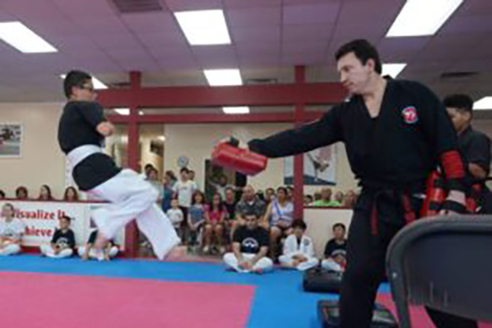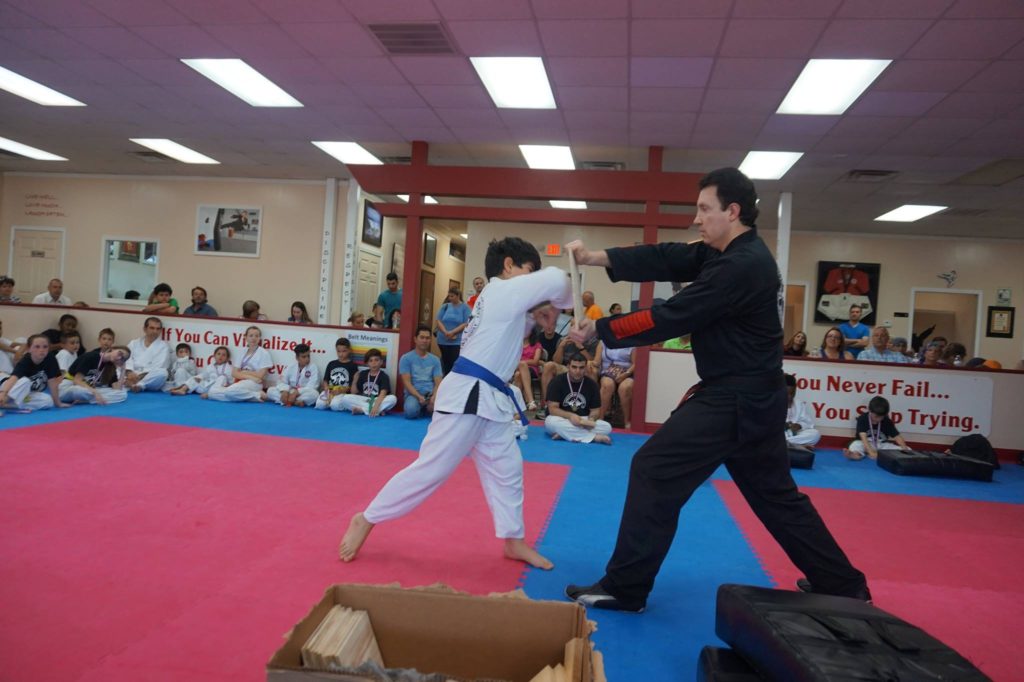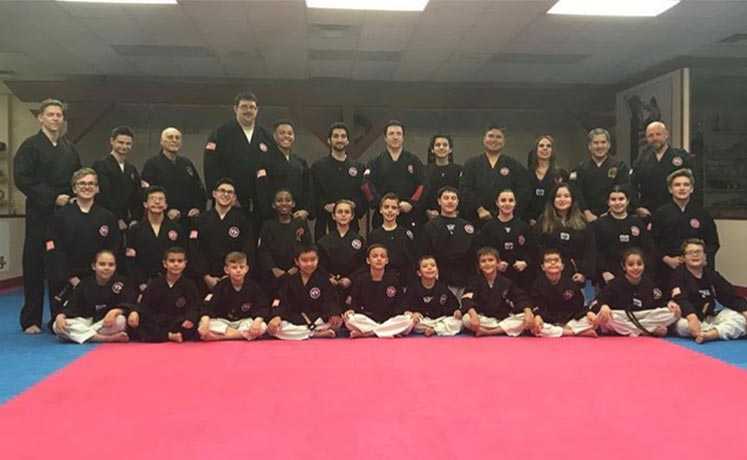Belt graduations

White & White with Black Stripe
The first rank in Tae Kwon Do is the white belt. Purity is often signified by the color white. The individual has no knowledge of Tae Kwon Do. These are the beginning steps of becoming a black belt.

Yellow & Yellow with Black Stripe
During the Yellow Belt rank, the student begins to understand the basics of Taekwondo. Once they have understood the basics, they move up to the orange belt.

Orange & Orange with Black Stripe
While students are ranked an orange belt, the student is using this time to take in knowledge. The students basic techniques are growing. This prepares them for the next belt graduation, the green belt.

Green & Green with Black Stripe
Out of all of the belts, the green belt, is in our experience, a milestone. I would say that most people never make it past this point. The student’s taekwondo knowledge and experience is growing at a good pace now. The color green represents the plant as it sprouts and begins to grow.

Blue & Blue with Black Stripe
Upon graduating from the green belt, students become a blue belt. At this point, the student should have a good foundation in taekwondo. The student is also prepared to begin learning more advanced techniques and theories. The color represents the sky toward which the plant reaches as it matures into a tree.

Red & Red with Black Stripe
After reaching the sky with the blue belt graduation, the next belt ranking is the Red Belt. The red belt has great meaning to a student, who knows quite a bit about taekwondo, and is enough to be dangerous. Now, the student must learn control, a very crucial skill in the martial arts world. The color red signifies danger, warning others to stay away and reminding the student to practice control.

Junior Black Belt (1st Degree)
Once students graduate from red belt, next comes the Junior Black Belt. This is the end of the introductory stages, levels that most students do not make it past. On average, this rank takes 3-5 years to reach. Traditionally, only after achieving the rank of black belt, is the pupil considered to be true student of taekwondo. It is without a doubt a great mark of progress, but is far from the end. Truly, the junior black belt ranking, is only the beginning. The definition of the color black is simple the opposite of the color white.

Novice Black Belt (1st-3rd degree)
After completing the Junior Black belt, the Novice Black Belt is next. This first three ranks of black belt are designated as Novice. The student should concentrate on perfecting the basics that they have learned, while also learning a good bit of new material. The student is also considered an Assistant Instructor during these ranks.

Expert Black Belt (3rd-6th Degree)
On average, the student has been an actively training and advancing black belt for 9-10 years before they may test for 4th degree. It is a very serious achievement, the student having been training as a black belt about twice as long as they were a colored belt. During this stage, the student should have enough understanding of taekwondo to begin pursuing theory more deeply. Many students begin to specialize as well, which means the student is qualified enough to be considered an Instructor.

Master Black Belt (7th-8th Degree)
Students who achieve this rank, the master black belt, are very knowledgeable. Most masters only teach other black belts, leaving the colored belts to the lower ranks.

Grandmaster (9th-10th Degree)
The Grandmaster rank, also known as the 9th degree and 10th degree black belt, is the ultimate rank in traditional taekwondo. Family Karate Academy’s Sam Kas Mikha is the youngest in the world to rank in this level. Grandmaster Kaz works hard each day to teach his students his values, along with the best techniques and tricks in Tae Kwon Do.

White & White with Black Stripe
The first rank in Tae Kwon Do is the white belt. Purity is often signified by the color white. The individual has no knowledge of Tae Kwon Do. These are the beginning steps of becoming a black belt.

Yellow & Yellow with Black Stripe
During the Yellow Belt rank, the student begins to understand the basics of Taekwondo. Once they have understood the basics, they move up to the orange belt.

Orange & Orange with Black Stripe
While students are ranked an orange belt, the student is using this time to take in knowledge. The students basic techniques are growing. This prepares them for the next belt graduation, the green belt.

Green & Green with Black Stripe
Out of all of the belts, the green belt, is in our experience, a milestone. I would say that most people never make it past this point. The student’s taekwondo knowledge and experience is growing at a good pace now. The color green represents the plant as it sprouts and begins to grow.

Blue & Blue with Black Stripe
Upon graduating from the green belt, students become a blue belt. At this point, the student should have a good foundation in taekwondo. The student is also prepared to begin learning more advanced techniques and theories. The color represents the sky toward which the plant reaches as it matures into a tree.

Red & Red with Black Stripe
After reaching the sky with the blue belt graduation, the next belt ranking is the Red Belt. The red belt has great meaning to a student, who knows quite a bit about taekwondo, and is enough to be dangerous. Now, the student must learn control, a very crucial skill in the martial arts world. The color red signifies danger, warning others to stay away and reminding the student to practice control.

Junior Black Belt (1st Degree)
Once students graduate from red belt, next comes the Junior Black Belt. This is the end of the introductory stages, levels that most students do not make it past. On average, this rank takes 3-5 years to reach. Traditionally, only after achieving the rank of black belt, is the pupil considered to be true student of taekwondo. It is without a doubt a great mark of progress, but is far from the end. Truly, the junior black belt ranking, is only the beginning. The definition of the color black is simple the opposite of the color white.

Novice Black Belt (1st-3rd degree)
After completing the Junior Black belt, the Novice Black Belt is next. This first three ranks of black belt are designated as Novice. The student should concentrate on perfecting the basics that they have learned, while also learning a good bit of new material. The student is also considered an Assistant Instructor during these ranks.

Expert Black Belt (3rd-6th Degree)
On average, the student has been an actively training and advancing black belt for 9-10 years before they may test for 4th degree. It is a very serious achievement, the student having been training as a black belt about twice as long as they were a colored belt. During this stage, the student should have enough understanding of taekwondo to begin pursuing theory more deeply. Many students begin to specialize as well, which means the student is qualified enough to be considered an Instructor.

Master Black Belt (7th-8th Degree)
Students who achieve this rank, the master black belt, are very knowledgeable. Most masters only teach other black belts, leaving the colored belts to the lower ranks.

Grandmaster (9th-10th Degree)
The Grandmaster rank, also known as the 9th degree and 10th degree black belt, is the ultimate rank in traditional taekwondo. Family Karate Academy’s Sam Kas Mikha is the youngest in the world to rank in this level. Grandmaster Kaz works hard each day to teach his students his values, along with the best techniques and tricks in Tae Kwon Do.
our students











